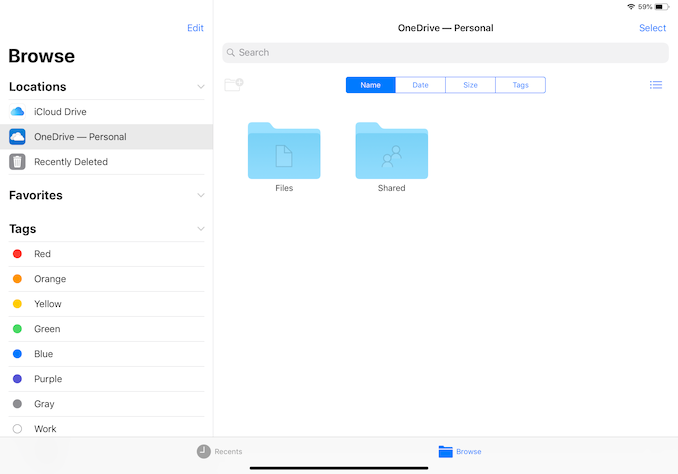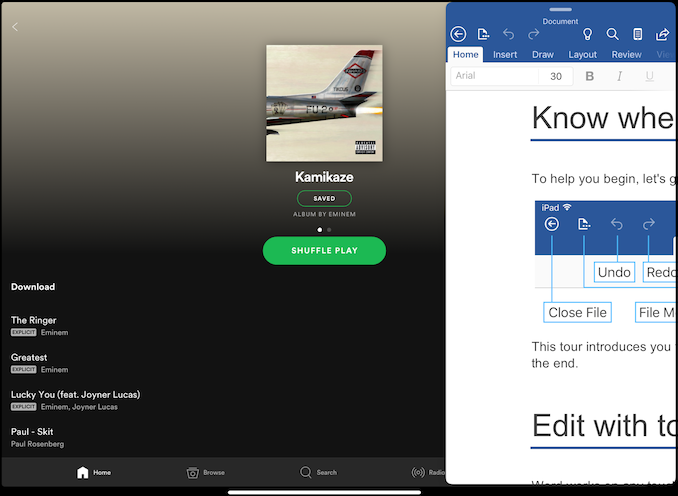The 2018 Apple iPad Pro (11-Inch) Review: Doubling Down On Performance
by Brett Howse & Andrei Frumusanu on December 4, 2018 10:00 AM ESTWireless
Apple has stuck with the same wireless solution as they offer in the iPhone, which is the Murata/Apple 339S00551 Wi-Fi controller. This is an 802.11ac 2x2:2 solution with 80 MHz channel support, and it integrated Bluetooth 5.0. The actual controller is likely a Broadcom unit, which is what Apple tends to use in its iOS devices.
Unfortunately, iOS doesn’t let us perform our standard copy script to provide peak throughput testing, so we can’t comment on that, however the iPad did lose connection the access point several times and would require a device restart to connect again. Switching to a different access point corrected this issue, but was a less than ideal solution.
On the cellular side, Apple has outfitted the LTE versions with Intel’s XMM 7560 modem, which offers Category 16 downloads.
Audio
As mentioned in the design section, the iPad Pro features four sets of speakers, with both a tweeter and woofer for each corner. There are drilled holes in the aluminum chassis to let the sound out, and the iPad offers dynamic audio based on its rotation so that the left and right channels of audio are directed to the correct side. If you turn the iPad 180°, the left and right channels will switch to keep the stereo correct. It is a great system that works flawlessly.
The actual speakers on the iPad sound very good, and on playback of a test track, were able to achieve around 85 dB(A) measured one inch over the device. There is no distortion, and the speaker range was quite good for a small device.
The bad news is if you want to connect your favorite headphones to the iPad, there is no longer a 3.5 mm jack. The reasoning behind the removal on the iPhone was due to space concerns, but on a larger device like the iPad, that seems like a weak argument. In addition, there’s no 3.5 mm USB-C adapter in the box either, so if you do want to use wired headphones, you’ll need to purchase an adapter. This is obviously less than ideal.
Cameras
Apple offers a 7 MP front facing camera with f/2.2, Smart HDR, wide color support, and "Retina Flash", which means it will use the display as a flash for the front facing camera. The front facing camera works well for Face Time, which is what it is really designed for, although the location of the camera in the top bezel in portrait means that it won’t work well in landscape, since everything is off-center. Ideally, Apple could offer two sets of cameras, which would also help out with Face ID.
The rear camera is a 12 MP f/1,8 with PDAF, Smart HDR, wide color support, and True Tone Quad-LED flash.
The rear camera is quite good, likely on-par with the iPhone XR.
![]()
Google Pixel XL camera samples
Due to the weather (it’s winter in Canada) the only samples here are from indoor shots compared against the Google Pixel XL.
Software
As I mentioned towards the start of this review, as Apple is pitching the iPad Pro as a professional productivity machine, I opted to go into this review focusing on just that. Meaning the competition for the iPad Pro isn't so much other ARM-based tablets, but rather similarly-capable business machines like the Surface Pro series or Lenovo's various Yoga devices. At this point I don't think the iPad Pro's pedigree in terms of hardware is in question. But rather it's a question of whether the software can do everything that a professional machine should be able to. The iPad is inseparable from iOS, for all the benefits and drawbacks that can bring.
Apple wants the iPad Pro to be a professional, or at least prosumer, level of device. And in order to achieve that they need not only the operating system, but also the applications available for people to get work done. The iPad’s success over the years was always offering easy access to content, but only in the last couple of generations has Apple put serious effort into letting people get work done on it via the iPad Pro family.
 The Files app doesn't provide access to any files on the device
The Files app doesn't provide access to any files on the device
iOS has come a long way in terns of its ability to multitask, but with the gesture based navigation it can be a bit cumbersome to switch applications on the fly. Over time, you do get better at it, but it still doesn’t compare to the PC. The four-finger swipe to switch between open applications is quick, but if you have several open it can be slow to get where you need to go. iOS 12 of course still supports the Split View and Slide Over modes as well. There’s also no file system access, other than the rudimentary Files application, and Apple has decided not to allow regular USB drives to be connected and used to transfer media. You can hook up a camera card and import the photos, and there are various iOS-specific drives out there that work on an application-by-application basis, but the only way to move the files off of the iPad is generally through the cloud.
 Since iOS requires the app developers to explicitly support their multitasking modes, if you want Word open with Spotify at the same time, this is your only option
Since iOS requires the app developers to explicitly support their multitasking modes, if you want Word open with Spotify at the same time, this is your only option
What it boils down to is that the iPad Pro offers a tremendous amount of performance, but at this point it feels held back by iOS. If you have a workflow that you know works well in iOS, it will almost certainly work better on the iPad Pro. But if you have a workflow from the PC, that will need to be adjusted to make it fit the iPad.
That’s not necessarily a bad thing. There are clearly people who can not only make the iPad work, but find it to be a better tool than what they had in the past, but that is not always the case. With more professional applications coming to iOS, this could improve over time as well, and Adobe in particular has been a strong supporter of iOS with their Creative Cloud applications.
Other features are also left wanting, such as the ability to hook the iPad Pro up to a 5K display over USB-C. At the OS level the only option here is to mirror the iPad display, but since the display you are connecting to likely doesn’t offer touch, and there’s no pointer support in iOS, it literally is just a cropped version of the iPad display on another screen. Apps can take advantage of the second display, such as a presentation which would offer a different experience on both displays, but it doesn’t offer the flexibility of the PC or Mac with regards to connecting extra monitors.
There are hundreds of small issues like this that you’ll run into when using iOS for professional-level productivity. Some of them will be real issues, and some of them will just be re-learning tasks. There’s no doubt you can get work done on the iPad Pro, but the question is if you can do it as efficiently as you are used to. If you can, great. This iPad is for you.













145 Comments
View All Comments
tipoo - Tuesday, December 4, 2018 - link
16nm did substantially cut its power use, and 16nm was less of a node leap than 7 (iirc it was closer to 22nm, but one of the finfett rebrandings?)Xbox One S 35-90
Xbox One 70-120
http://energyusecalculator.com/electricity_gamecon...
PeachNCream - Tuesday, December 4, 2018 - link
Yup, that is an impressively quick bit of hardware hiding inside the new iPad. It doesn't speak well for a lot of hardware that soaks up a bunch more power and needs a lot more cooling to accomplish similar task. I'm hoping the A12X will be something of a kick in the proverbial pants for the rest of the chip industry to get off their behinds and deliver better performance at much lower TDP, that is both CPU and GPU companies that are inflating real TDP to comparably absurd levels while chasing incremental and insignificant increases in performance.sing_electric - Tuesday, December 4, 2018 - link
To be fair, the A12 is one of the first 7nm chips to ship. AMD's Ryzen 2700U, in theory, is at least as powerful, but is built on a 12nm process so it consumes more power.A year from now, its very likely that AMD will have a mobile Ryzen built on the 7nm same process at the same foundry (TSMC) as Apple, which has the possibility of being more powerful at the same power consumption depending on workload (again, AMD and Apple optimize for different things in their chips, and an.... Apple to oranges comparison is hard to make).
Within a couple years, we'll see how Intel's new GPU unit does - they've committed to releasing dGPUs but you'd have to think that a side effect would be increased performance of their iGPUs as well. IF they're finally able to start mass-manufacturing on their 10nm (and future) process, they should be competitive as well.
Spunjji - Wednesday, December 5, 2018 - link
+1 to this. Very interested in what Intel can do at low TDPs given their experience there. UHD620 is an old architecture now, so you have to wonder what all the intervening development will grant their first real next-gen GPU.AMD have been struggling of late but it sounds like, if they coalesce their development around Navi, they should see some serious benefits at low TDPs too.
GruenSein - Tuesday, December 4, 2018 - link
I actually considered buying the new iPad Pro but as long as iOS and its and 3rd party apps keep working the way they are working, all that performance is wasted IMHO. For the device to be really productive, a real file browser and full access to files is required. Let me organize my files the way, I want. The share button and weird iCloud browser doesn't cut it. Professional workflows require multiple apps to work on the same files, so, as antiquated as Apple wants to make it feel, an "open with" and "save as"-Dialog is crucial. Same goes for file access and network integration. Why can't I access SMB-shares? Most iOS users I know still send files per eMail because that is still the most convenient way to do it. The 3rd party file browsers can help but it is still hardly possible to use these files in any other apps. Some actually start a streaming server if you want to play media with VLC because you cannot tell the app to simply open the file.From my point of view, the hardware is great and way ahead of the competition. But the software is keeping it at a toy level for the time being.
melgross - Tuesday, December 4, 2018 - link
Well, far from a toy level, which you would know if you used one. But you’re right that some things are just not available, or not up to snuff. Apple was expected to make major changes to iOS this year for the iPad Pro, but held off until next year due to the rwoerking of the OS for efficiency so that older devices would work better, as well as more modularizing the OS and getting rid of some higher level bugs.I hope these expected changes to the Desktop next year not only involve the look and function of the Desktop, but also full use of the USB port for mass storage and hierarchical folders.
Apple seems to be moving in the right direction, but more slowly than I would like.
sing_electric - Tuesday, December 4, 2018 - link
At this point, I'll believe it when I see it. Adobe had to get very creative with handling files on iOS to bring real Photoshop to the iPad, and they've got the "benefit" of their own cloud platform that they've foist on all their current customers.And lack of pointer support is getting harder to stomach - its annoying for pro-users with a keyboard, and it ALSO really limits the ability of people who use assistive communication devices to use iOS AT ALL since a lot of them work via mouse drivers. You'd think adding decent mouse support would be like, a weekend project for a team of engineers.
melgross - Tuesday, December 4, 2018 - link
Adobe ran that file at the presentation while it was residing on the iPad. You can’t do that from the cloud. That’s storage, not live functioning in the app. It doesn’t matter how they did it on the iPad. The fact is that they did, and it was very impressive indeed.Pointer support isn’t a matter of a team of engineers. It’s a matter of philosophy. Apple, at this time, still doesn’t believe in it. I don’t happen to agree with their stance. With the original 9.7” iPads, sure, but not for the bigger Pro models. So I agree there.
But even without it, things work dine in most cases. Would I want to write a novel 9n it? No, but I can get away with several pages of writing.
iOS is praised for its ability with assisted communications. Not as good as the Mac, but better than Android by a long shot.
I’m happy to see what happens in the developers conference next June. We should have a good idea where their going then. If nothing much happens, I’d be surprised. I don’t expect everything I want, but some of it.
MonkeyPaw - Tuesday, December 4, 2018 - link
Yeah, mouse support is probably a toggle away in their development process. Anyway, Affinity Photo for iOS is impressive, with both cloud and local storage options. Local photos much be handled through iOS Photos, and traditional file management must be through the files app/cloud service of your choosing. Not as many options as a desktop, but there are at least some options.KPOM - Tuesday, December 4, 2018 - link
Mouse support is a double-edged sword. It would make some things easier but also make other things harder, particularly if apps “expect” a cursor.